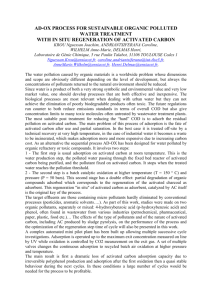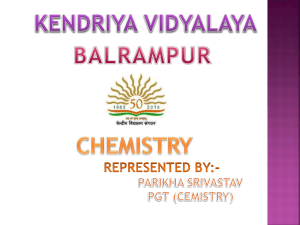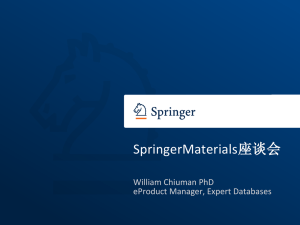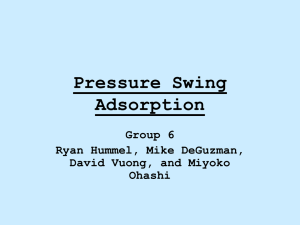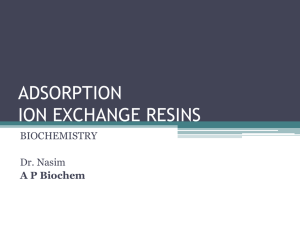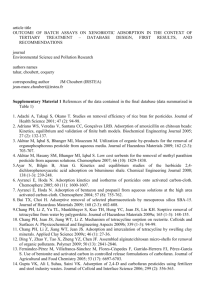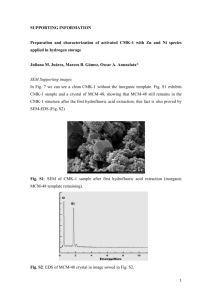surface chemistry un..
advertisement
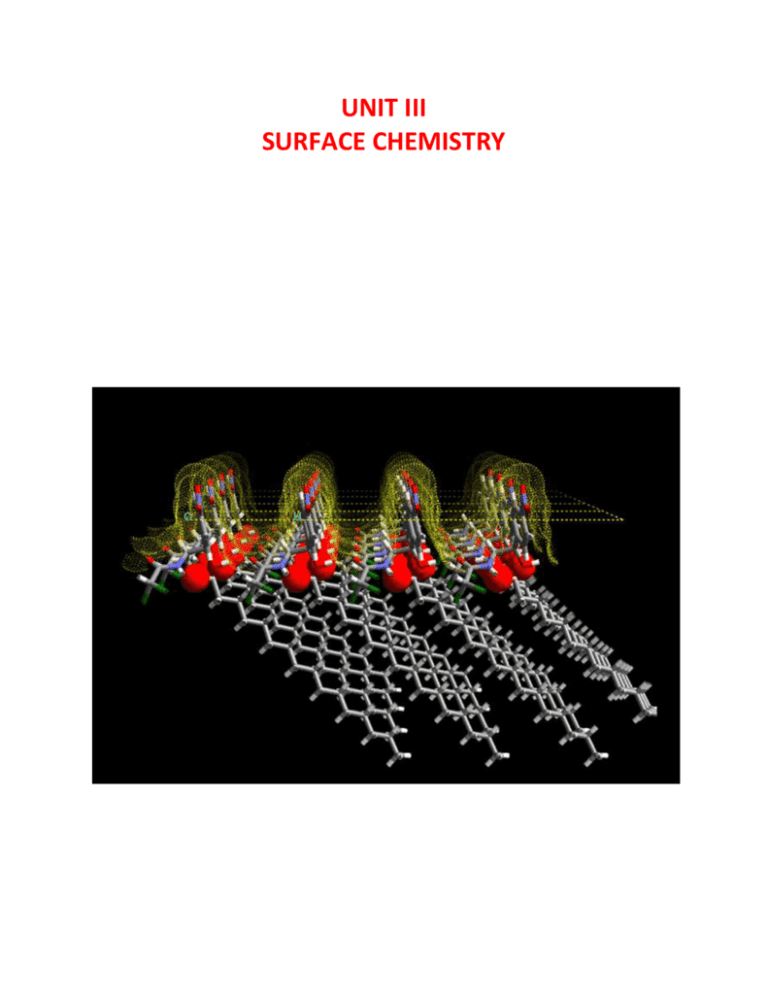
UNIT III SURFACE CHEMISTRY UNIT III SURFACE CHEMISTRY DEFINITIONS ADSORPTION It is a surface phenomenon. In this, concentration of any molecular species is greater at the surface than in the bulk. The phenomenon of accumulation of gas or liquid molecules on the surface of a solid or liquid is called adsorption. The adsorption of gas on a solid is sometimes called occlusion. Ex : Adsorption of ammonia (adsorbate) in charcoal (adsorbent) Adsorption of water vapours (adsorbate) on silice gel (adsorbent) Adsorption of dye (adsorbate) by charcoal (adsorbent) Absorption It is a bulk phenomenon. It is a process in which, a substance is not only retained on the surface but uniformly distributed throughout the body of the solid or liquid Ex : Absorption of ammonia by water Absorption of water vapours by only CaCl2 Absorption of water by sponge Adsorbate The substance on the surface of the solid is called the adsorbate. Ex : Various gases (NH3, CO2, N2, O2 etc.) Adsorbent The substance to which the adsorbate is attached is called adsorbent. Ex : Silica gel, charcoal, alumina gel, clay, Pd, Pt, Ni Sorption The process in which both adsorption and absorption takes place simultaneously. CHARACTERISTICS OF ADSORPTION Adsorption is a physical phenomenon but accompanied by a chemical change. It is a spontaneous process It is a selective process It is always accompanied by evolution of heat It is specific The rate of adsorption depends on temperature. It depends on the nature of adsorbent and adsorbate. DIFFERENCE BETWEEN ADSORPTION AND ABSORPTION Adsorption - Surface phenomenon - Rapid process - Equilibrium is attained easily - Concentration of molecule are more on the surface and less in the bulk - NH3 adsorbed on charcoal Absorption - Bulk Phenomenon - Slow process - Equilibrium is slowly , step by a step - Distribution is uniform - NH3 absorbed by water TYPES OF ADSORPTION Adsorption is classified into two types 1. Physical adsorption (or) vander waals adsorption (or) physisorption. 2. chemical adsorption (or) activated adsorption (or) chemisorption. Physical adsorption (or) physisorption It is the one in which the adsorbed molecules are held on the surface of the adsorbent by weak physical or Vander waal’s forces of attraction. Ex. Adsorption of H2 (or) O2 on charcoal Chemical adsorption (or) chemisorption It is the one in which the adsorbed molecules are held on the surface of the adsorbent by chemical bonds (covalent bond (or) ionic bond) Ex. Adsorption of H2 on NI. DIFFERENCE BETWEEN PHYSISORPTION AND CHEMISORPTION Physisorption - Due to inter molecules vander waal’s forces - Low heat of adsorption (o-40 K.cal/mol/) - Easy and fast process -Reversible -Decreases with increase in temperature -The rate of adsorption increase with increases of pressure and concentration -Multi layer adsorption occurs -Not specific -No surface compound form action takes place. -Equilibrium is established rapidly -Involves very small activation energy Chemisorption -Due to story chemical bond formation. - High heat of adsorption(40 – 400 k.cal/mol) -Difficult and slow process -Irreversible -Increases with increases in temperature. -The rate of adsorption decreases with increase of pressure and concentration. -Monolayer adsorption occurs. - Highly specific -Surface compound formation takes place. -Requires time -Involves appreciable activate energy ADSORPTION OF GASES ON SOLIDS The magnitude of adsorption of gases by solids depends on the following factors. 1. Nature of the adsorbent 2. The surface area of the adsorbent 3. Nature of the gases 4. Pressure of the gas 5. Temperature of the gas 6. Reversible character of the adsorbed gases 7. Activation of the adsorbent 8. Enthalpy of adsorption FACTOR INFLUENCING ADSORPTION OF SOLUTES FROM SOLUTIONS The amount of solute adsorbed by a solid from the solution depends on the following factors. 1. Effect of temperature A rise in temperature increases the kinetic energies of solute particles and hence these particles leave the surfaces and thereby lowering the extent of adsorption. Frendlich adsorption equation is found suitable to explain the effect of concentration. If a graph is drawn between log x/m Vs log c, a straight line is obtained for small changes of concentrations. i) when the solute is adsorbed by an adsorbent it is called positive adsorption. ii) But of the solvent is taken up by the adsorbent it is called negative adsorption. a. Negative adsorption Adsorption of substance from the solution decrease with rise in temperature and decrease in concentration of solution. This type of adsorption is known as negative adsorption. Ex. Adsorption of water From the dilute solution of KCl, charcoal adsorbs water, thereby the concentration gets increased. b. Positive adsorption Adsorption of substance from solution increases with decreases in temperature and in concentration of solution. This type of adsorption is concentration of solution. This type of adsorption is known as positive adsorption. Ex. Adsorption of salt (KCl) Charcoal adsorbs KCl rather than water thereby salt concentration gets decreased. i) The nature of the solute adsorbed The extent of adsorption is usually greater when the molecular weight of the solute is high. ii) Effect of surface area If the surface area of the adsorbent is increased, adsorption also increases. FACTORS INFLEUNCE ADSORPTION OF GASES ON SOLIDS 1. Nature of the adsorbent The adsorption depends upon the type of adsorbent used. The excellent adsorbents are highly porous in nature. The larger the pores, the greater is the adsorption. Ex : porous substances are silica gel, aluminia and charcoal. The adsorption power of these substances can further be enhanced by a pores called activation. During activation, the adsorbent is heated in steam to about 1500°c. Heating drives out all impurities and leads to a lager free surface for adsorption. Ex. Charcoal adsorbs 0.011 gms of CCl4 at 24°C. Activated charcoal adsorbs 1.48 gm of at 24°C. The surface area of adsorbent The extent of adsorption depends on the surface area. 1. The greater the surface area, the greater is the adsorption. 2. Larger pores on the adsorbent, larger is the adsorption. Ex. Charcoal and silica gel ( excellent adsorbents). Nature of gases The amount of gas adsorbed by a solid depends on the nature of the gas. Easily liquefiable gases like Hl, NH3, Cl2, SO2 etc., are adsorbed more easily then the permanent gases like H2, N2, O2 etc., This is due to the following reasons : i. Critical temperature The ease of liquifications depends on its critical temperature (i.e, the maximum temperature above which a gas cannot be liquefied). Thus if the critical temperature of the gas is more, it will be liquefied and adsorbed more readily. Ex. Adsorption of various gases on 1g of activated charcoal. ii. Vander waal’s forces Easily liquefiable gases possess greater vander waal’s forces than permanent gases, so they are adsorbed more readily. ROLE OF ADSORBENT IN CATALYTIC REACTIONS Adsorbent in Heterogeneous catalytic reaction Adsorption plays a major role inmost of the industries. Various manufacturing industrial chemical process are heterogeneously catalyst reactions. The function of catalyst is to increase the rate of the reaction and it does not affect the equilibrium. The reaction mechanism includes the following steps. Step 1 : Adsorption of reactant molecules on the surface of the solid. Step 2 : Formation of activated complex. Step 3 : Decomposition of activated complex. Step 4 : Desorption of products. ROLE OF ADSORBENT IN CATALYTIC REACTIONS (OR) ADSORPTION (OR) CONTACT THEORY 1.Action of heterogeneous catalyst: Hydrogenation of ethylene using Ni catalyst. Step :1 Adsorption of reactant molecule Step:2 Formation of activated complex Step:iii Decomposition of activated complex Step iv: Desorption of product: The products are desorbed (or) released from the surface. They are stable. 2.Finely divided state of catalyst is more efficient Fineness of the catalyst increase, the free surface area gets increases, thereby free valencies increases. Free valencies=12 . 3.Enhanced activity of a rough surfaced catalyst It possess “ Cracks”, “Peaks”, “Corners” etc., and consequently have larger number of active centers. These active centers increase the rate of reaction. 4.Action of promoters Promoters are defined as the substances, which increase the activity of a catalyst. (i) Promoters change the lattice spacing (ii) Promoters increase the peaks and cracks 5.Action of catalytic poisons Catalytic poison is defined as a substance which destroys the activity of the catalyst to accelerate a reaction.This process is called catalytic poisoning. CLASSIFICATION OF ACTIVATED CARBON Activated carbon is classified into two main classes based on their size and different adsorption capacities. 1. Granular Activated Carbon These types of carbons have a diameter greater than 0.1 mm. It is used for adsorption of gases and vapours. Carbon is classified into two main classes based on their size and different adsorption capacities. 2. Powdered Activated Carbon These types of carbons have a diameter of less than 200 mesh. It is used for purification of liquids. Activated of Carbon During activation, charcoal is heated in stream or air atmosphere to about 1500°C. Heating drives out all the impurities as gases and these by leads to a layer surface for adsorption. a. Direct Method In this method, activation is carried out by heating carbon in steam or air at about 850°C. Heating drives out all the impurities sticking on the surface and blocking the capillary poles. This leads to a large surface area of carbon. b. Briquetting Method The powdered carbon is mixed with wood ear and caustic soda compressed into small briquettes and then heated in steam at 800°C. c. Chemical Method The wood is impregnated with a solution of Zinc Chloride or Phosphoric acid and then carbonized. ROLE OF ACTIVATED CARBON IN WASTE WATER TREATMENT The waste water contains number of compounds which are resistant to biodegradation and persist in water even after primary and secondary treatments. These impurities are generally carcinogenic and toxic in nature These compounds may be eliminated by passing over a bed of granulated activated carbon (GAC). These compounds present in waste water are adsorbed by charcoal and removed from water. a. Treatment of waste water 1. Using a trickling filter method The small quantities of dissolved organic hazardous waste can be removed by this method. The filter consists of a number rectangular or circular vessels. These vessels are packed with granular activated carbon (GAC). GAC has an enormous surface area (about 1000 m2/g) and is commonly used as adsorbent. Process The contaminated water is allowed to trickle down through the GAC packed in a series of vessels. As the trickled waste water starts percolating down wards through the granular activated carbon the hazardous organics in polluted water are adsorbed on the porous GAC matrix. The GAC filter after sometime gets clogged with the adsorbed contaminates and hence must be replaced or regenerated for further use. Regeneration When the charcoal becomes saturated, it is heated in vacuum to above 1500°C and the adsorbates are driver off. Activated carbons used in other industries 1. Refining of sugar, glucose. 2. Removal of taste & colour of drinking water. 3. Removal of metals from waste water 4. Removal of impurities from pharmaceutical. Role of activated carbon in air Finally powdered activated carbon is an excellent adsorbent for the removal of toxic gaseous pollutants of impure air. It is used to remove impurities like NO2, SO2, CO and CO2 from impure air. a. Treatment of polluted air Using charcoal adsorption tube - In this technique, the polluted air is sucked by the tube and is passed through a glass wool. The pollutants in air are adsorbed on the granular activated charcoal. The amount of pollutant adsorbed is proportional to the surface area of the adsorbent and the Physics, Chemical characteristics of the adsorbent. The temperature are pressure are maintained during the process. The GAC filter after sometime gets clogged with the adsorbed contaminates. The adsorbed pollutants can be leached with a suitable solvent such as carbon disulphide and the solution is analysed by gas chromatography. DERIVATIONS OF FREUNDLICH'S ADSORPTION ISOTHERM This equation may be derived from the result observed from the graph . Thus i) At low pressure adsorption increasesX x p ii) At high pressure adsorption is almost constant X = constant iii) At intermediate (normal) pressure adsorption depends on 0 to 1 power of pressure. X x p 1/n (or) X = KP1/n m where, n = whole number. The above equation is called freundlich’s adsorption is other. Testing of Freundlich adsorption isotherm Taking log on both sides, the equation x = KP 1/n becomes log x = log k + 1 log p m/ n on plotting log x/m Vs log p, a straight line is obtained with a scope of 1/n and intercepts log k. Disadvantages or limitation of Freundlich's adsorption isotherm 1. Freundlich equation is purely empirical and has no theoretical basis. 2. The equation is valid only upto a certain pressure and invalid at higher pressure. 3. The constants K and n are not temperature independent, they vary with temperature. 4. Frendilich’s adsorption isotherm fails when the concentration of the adsorbate is very high. LANGMUIR’S ADSORPTION ISOTHERM Langmuir derived an equation based on some theoretical considerations. The assumptions of Langmuir’s theory are, 1. Valencies at the surface of the adsorbent are not fully satisfied. 2. The adsorbed gas layer on the solid surface is only one molecule thick. 3. The surface of the solid is homogeneous, so the adsorbed layer is uniform all over the adsorbent. 4. There is no interaction between the adjacent adsorbed molecules. 5. The adsorbed gas molecules do not move around the surface. 6. The process of adsorption is a dynamic process, which consists of two oppositeprocesses. Condensation Process It involves the condensation of the molecules of the gas on the surface of the solid. Evaporation Process It involves evaporation of the molecules of the adsorbate from the surface of the adsorbent. DERIVATION OF LANGMUIR ISOTHERM According to Langmiur’s assumptions, when the gas molecules strike a solid surface, some of the molecules are adsorbed where some are desorbed. Thereby dynamic equilibrium is established between adsorption and desorption. Consider an adsorbing surface of area 1 square cm exposed to a gas. Then q - Fraction of the surface area covered by gas molecules 1- q - Fraction of the uncovered area (vacant area) r - Pressure of the gas The rate of adsorption = Ka (1-q)p – (1) The rate of evaporation desorption of gas molecules = Kd q - (2) Where K1 & K2 are proportionality constant for a given system. At equilibrium : Rate of adsorption = Rate of desorption Ka(1-q)r = Kdq Kar = Kdq+ Karq Kar = q (Kd+ Kar) q = Kar/Kd+Kar - (3) Dividing the Eq. (1) by ‘ Kd’ it becomes q = Ka/Kd) r/ 1+ (Ka/Kd) r q = K r / 1+ K r Where, Ka/Kd = b = equilibrium constant, called the adsorption coefficient. But the amount of gas adsorbed per gram of the adsorbent (x)/m is proportional to the fraction (q) of the surface covered. On comparing Eq (2) & (3) it becomes x/k = k’kr /1+kr - (4) where K’ = the new constant. Equation (4) gives the relation between the amount of gas adsorbed to the pressure of the gas at constant T is known as Langmuir adsorption isotherm. The above Eq. (4) may be rewritten as 1+kr = k’kr / x 1/k’k + kr / k’k = r/x - (5) Equation (5) represent a straight line (i.e. y = c + mx) If the graph is plotted between r/x Vs r, we should get a straight line with slope k/k’k and the Intercept 1/k’k This equatin is found valid in all cases. Plot of r/x Vs r Case (1) : At low pressure If the pressure r is very low k/k’k , the r term is negligible. i.e. 1/k’k >> k/k’k r Hence Eq. (5) becomes 1/k’k = r/x (or) x = rk’k - (6) xµr i.e. amount of adsorption per unit weight of adsorbent is directly proportional to the r at low pressure. Case (ii) at high pressure. If the pressure r is high 1/k’k term is negligilble, i.e. k/k’k Hence Eq (5) becomes k/k’k r = r/x or x = k’ (constant) x = k’p° - (7) i.e. extend of adsorption is independent of pressure of the gas, because the surface becomes completely covered at high pressure. Case (ii) At normal pressure If the pressure r is normal (intermediate) the eq. (7) becomes X = k’pn - (8) Where n lies between 0 to 1 Equation (8) is called Frendliech’s adsorption isotherm. Merits – Langmuir's adsorption isotherm holds good at low pressure. Demerits - It fails at high pressure. ROLE OF ADSORBENTS IN ION–EXCHANGE ADSORPTION Role of adsorbents in Ion – exchange adsorption Definition Ion – exchange adsorption is defined as, “the process of releasing”, the one kind of ion and adsorbing another same kind of ion by an adsorbent”. Classification of ion-exchangers 1. Cation exchange resin or cation exchanger or Decationizer resin. 2. Anion exchange resin or anion exchanger or Deanionizer resin. 1. Cation exchanger or Decationizer resin : These resins are insoluble in water. When water containing salts like MgCl2, CaCl2 is passed through the cation exchanger, it exchanges cations with other cations present in the hardwater. The resins are made from styrene divi.,benzene,copolymer containing, acidic functional groups like sulphonic(-SO3H) acid. It is represented as RH+. Definition : It is defined as cross – linked polymer containing sulphonic group as integral part of resin and an equivalent amount of H+ ions. Process : When the solution, containing certain Ca2+, Mg+ is allowed to pass through it H+ ions are exchanged for cations present in solution. 2RH+ + Ca2+ --> R2 Ca2+ + 2H+ 2RH+ + Mg2+ --> 2RMg2+ + 2H+ This process consists of desorption of H+ ions and adsorption of Ca2+, Mg2+ ions by the resin. 2. Anion exchanger or Deanionizer resin When water is passed through anion exchange column, the resin is capable of exchanging their anions with other anions. The resin consists of quaternary ammonia hydroxide groups (-NR3OH) or amino group etc., on the benzene rings of styrene – divinyl benzene copolymer. This may be represented as R’OH_. Definition : Anion exchange is defined as “Cross-linked polymer containing amino group as integral part of resin and an equivalent amount of OH_ ions. Process : When the solution of another anion is allowed to pass through it, OH_ ions are exchanged by anion present in the solution. R+ OH_ + Cl_ --> R+Cl_ + OH_ It also involves desorption of OH_ ions and adsorption of Cl_ ion by the resin. Regeneration When the cation exchange resin is exhausted it can be regenerated by passing a solution of dil. HCl. R2 Ca 2+ 2H+ --> 2RH+ + Ca2+ When the anion exchange column is exhausted it can be regenerated by passing a solution of dil.NaOH. R+ Cl_ + OH_ --> R+ OH_ + Cl_ Applications of Ion – exchange Adsorption a. In this process not only hardness causing salts are removed, but also salts of trace metal from the water. E.g. Zeolite process and demineralization process etc. b. Complex metal ions such as copper and nicked also can be removed from water used in industries. c. Ion exchange technique can be applied for concentration of uranium in pitchblende ore. TREATMENT OF POLLUTED WATER AND AIR 1.Using Granular Activated Carbon (GAC) A fixed – bed column is often used for contacting polluted water or air with GAC.It can be operated singly, in series or in parallel.Among the various type two are important. 1. Down flow carbon contactors. 2. Upflow carbon contactors. (A) Down flow Carbon Contactors It usually consist of two (or) three columns operated in series (or) in parallel. The water or air is applied to the top of the column and withdrawn at the bottom. The AC is held in place with an under drain system at the bottom of the column. Provision for back washing and surface washing is usually necessary to limit the headless build up due to the removal of particle material with the carbon column. Advantage Adsorption of organic materials and filtration of suspended solids are accompanied in a single step. Disadvantages Down flow filters may require more frequent back washing because of the accumulation of suspended materials on the surface of the contactor. Plugging of carbon pores may require premature removal of the carbon for regeneration, thereby decreasing the useful life of the carbon. (b)Upflow Carbon Contactors In the upflow columns, the polluted water or air moves upward from the base of the column . Advantage: As the carbon adsorbs organic materials, the apparent density of the carbon particles increases and encourages migration of the heavier or spent carbon downward. Disadvantage upflow columns may have more carbon fines in the effluent than downflow columns, because upflow tends to expand, not compress, the carbon. Bed expansion allows the fines to escape through passage ways created by the expanded bed. 2.Using Powdered Activated Carbon (PAC) In this method PAC is added directly to the effluent coming out from the various biological treatment processes. In the case of biologicaltreatment plant effluent, PAC is added to the effluent in a contacting basin. After some time, the carbon is allowed to settle at the bottom of the tank, and the treated water is then removed from the tank. Since carbon is very fine, a coagulant such as polyelectrolyte may be added to aid the removal of the carbon particles or filtration through granular medium filters may be required. Regeneration of Activated Carbon Thermal methods are widely and effectively used. (i)Granular carbon It can be regenerated easily in a furnace by heating in the presence of limited amount of water vapour, flue gas and oxygen. Some of the carbon (5 to 10%) is destroyed in the regeneration process and must be replaced with new carbon. (ii) Powdered carbon This methodology is not well-defined. The use of powdered AC, produced from recycled solid wastes, makes no need of regenerating the spent carbon. Applications of Activated Carbon There is no particular AC that is effective for all purposes. *In odour control As a decolourant In solution purification In gas masks-to adsorb poisoning gases. In Air Conditioning-to control odour. In industrial recovery Activated carbon adsorbs practically any organic solvent at about 35 oC and releases it when heated to 120 oC or higher for solvent recovery. *In cigarette filters-Specially impregnated are used. In the removal of organic and inorganic compounds It is generally used for the removal of the refractory organic compounds as well as residual amounts of inorganic compounds such as nitrogen, `sulfides and heavy metals. In odour control : Activated carbon adsorbets are commonly used for odour control . activated carbon has different rate of adsorption for different substances. In soln purification Activated carbon is also used in cleaning sugar soln. In gas masks The vapour adsorbent type of activated carbon is used in gas masks. Activated carbon is also effective in adsorbing organic molecules even from humid gas and stream. Role of adsorbents in ion exchange adsorption : Ion exchange adsorption is defined as the process of releasing the ion and adsorbing another like ion. Classification of ion –exchangers: 1.cation exchanger 2.Anion exchanger Softening(or)conditioning method: The process of removing hardness producing salts from water is known as softening(or)conditioning of water. This method can be done in 2 methods 1.External conditioning 2.Internal conditioning External conditioning: Ion exchange (or)demineralization process. Cation exchanger: Resins containing acdic functional groups (COOH, SO3H ) are capable of exchanging their H+ Ions with other cations .cation exchange resins is represented as 1.sulphonated coals. 2.sulphonated polystyrene RSO3H Anion exchanger: Resins contains basi functional groups (NH2,OH) are capable of exchange their anions with other anions .anion exchange resin represented as R’(OH)2 EX:1.cross linked quaternary ammonium salts. RH2+CaCl2→RCa+2HCl RH2+mgso4→Rmg+H2SO4 RH+NaCl→RNa+HCl Calogen conditioning Calogen is sodium hexa meta phosphateNa2[Na4(PO3)6] 2Caso4+Na2[Na4(po3)6+→Na2[Ca2(PO3)6]+2Na2SO4 The complex Na2[Na4(po3)6] is soluble in water and ther is no problem of sludge disposal. So calogen conditioning is better than phosphate conditioning. Zeolite process: Hard water contains Ca2+&Mg2+ ions this ions form hard soap (in soluble)with soap which does not produce lather with soap soln. Hard water is softened by passing it through a column packed with sodium cation exchange resin (called sodium zeolite ) Na2Ze+Ca2+→CaZe+2Na+ Synthetic zeolite is represented by Na2Ze. The sodium ions which are loosely held in Na2Ze are replaced by Ca2+ and Mg 2+ ions present in the water. Process: Sodium ions with Ca2+ and Mg 2+ ions present in the water to form Ca and Mg ions present in the water. Ca(HCO3)+Na2Ze→ CaZe+2NaHCO3 Mg (HCO3)+Na2Ze→ MgZe+2NaHCO3 CaSO4+ Na2Ze→ CaZe+Na2SO4 Mg SO4+ Na2Ze→ Mg Ze+Na2SO4 CaCl2 +Na2Ze→ CaZe+2NaCl Mg Cl2 +Na2Ze→ Mg Ze+2NaCl Regeneration: CaZe+2Na+Cl-→Na2Ze 1.water softening (demineralization process) The hard water first passed through a cation exchange column .which adsorbs all the cations like Ca 2+,Mg 2+ RH2+CaCl2→RCa+2HCl RH2 +Mgso4→RMg +H2SO4 Regeneration: RCa +2HCl→RH2+ CaCl2 RNa +HCl→ RH+ NaCl CaZe+ 2Na+ Cl- →Na2Ze +CaCl2 Electrical demineralization of water Ion exchange resins supported on paper or fibre can be used as membranes called ion – selective membranes. Regeneration: RCa+2HCl→RH2+CaCL2 RNa+HCl→RH+NaCl R’Cl2+2NaOH→R’(OH)2+2NaCl Carbonate conditioning: scale formation can be avoided by adding Na2CO3 to the boiler water. CaSO4+Na2CO3→CaCO3+Na2SO4 Phosphate conditioning: scale formation can be avoided by adding sodium phosphate. 3CaSO4+2Na3po4→Ca3(po4)2 Trisodiumphospate Na3po4(Weaklyalkaline) used for too acidic water. Disodium hydrogen phosphate-Na2HPO4(weakly alkaline) used for alka weakly acdic water. Sodium dihydrogen phosphate-NaH2PO4(acidic) used for alkaline water. Process: the cation selective membrane permits only cations but not anions .anion selective membrane permits only anion but not cation. Medical uses: Excess sodium salts from the body fluids can be removed by giving a patient a suitable ion exchanger to eat. Weakly basic anion exchanger are used to remove excess acid (or)acidity in the stomach. Applications of Adsorption The process of adsorption finds its application in following areas. 1. Silica and Alumina Gels These are used as adsorbent for removing moisture and for controlling humidities of room. 2. Activated charcoal a) It is used in gas masks, which adsorp all underivable (toxic) gases, while purified air passes through its poles. b) It is also used for removing colouring matter from the sugar solution and the decoloration in vinegar. 3. Fuller’s Earth It is used in large quantities for refining petroleum and vegetable oil since it adsorbs unwanted materials. 4. Mordants These are used in dying industry, which adsorp the colouring matter without attaching to the fabrics. 5. Froth Flotation process The sulphide ores are freed from silica and other earthy matter by froth – floatation process. (Oil adsorbs sulphilde ores only, but not others). 6. Ion – exchange resins Softening of hardwater can be done based on the principle of competing adsorption using ion-exchange resins. 7. Arsenic poisoning Colloidal ferric hydroxide is administered, which adsorbs arsenic poison and is removed from the 60 day by vomiting. 8. Chromatographic Analysis Selective adsorption by alumina, magnesia, etc. can be used for separating different pigments and also mixtures of small quantities of organic substances with the help of adsorption chromatography. 9. Measurement of surface area Surface area of powders and rough surfaces can be measured using adsorption measurements. The relationship between the magnitude of adsorption (x/m) and p can be expressed mathematically by an empirical equation known as freundlich adsorption isotherm. x = KP1/xm where, x – amount of gas adsorbed m – mob of adsorbent P – equilibrium pressure t,n – constants (depends on nature of adsorbate, adsorbent and T) ***************



